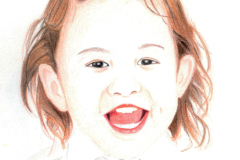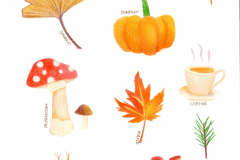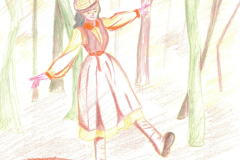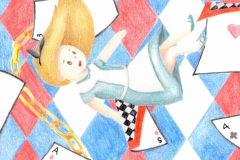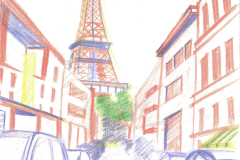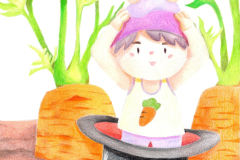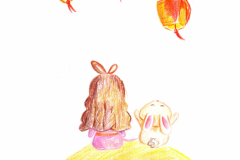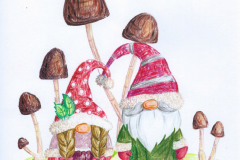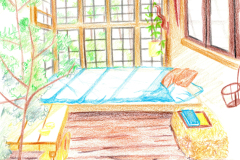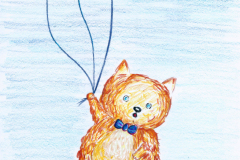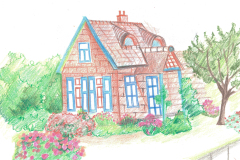Introduction
Joining the Urban Sketchers community offers a unique chance for anyone interested in art to grow creatively. Urban Sketchers are artists who draw scenes from real life right where they see them. This group started online and grew into a worldwide nonprofit organization. The community shares their artwork and stories, encouraging others to express what they observe in the places they live or visit.
Whether you are a beginner or have been drawing for years, joining this community can boost your skills. You will find support, learn new techniques, and share your work with others who enjoy sketching just like you. This article will explore how being part of the Urban Sketchers community can help you develop your creativity and become a better artist.
Why Sketch On Location
Drawing on location offers a kind of immediacy that you just can’t get from photos or memory. When you’re right there, in the middle of a street or a park, something shifts. The scene isn’t flat; it has depth and life. You notice subtle things—a shadow lengthening, a person’s posture, the way light bends around corners. These details shape your sketch in ways you might miss otherwise.
Sketching outdoors pushes your eyes to observe actively. It teaches you to understand how perspective changes as you move or as the world moves around you. This isn’t just about accuracy; it’s about developing a sharper sense of space and proportion that stays with you.
Then there’s the environment itself—the sounds, the smells, the air. They influence your mood and, indirectly, your lines and colors. You can almost feel the weather on your paper, even if you sneak in a quick drawing during a sudden drizzle.
It’s also a learning experience in patience and adaptation. Things don’t wait. People walk by, clouds cover the sun, a bus honks behind you. You adapt, focus, and capture the essence before it slips away. Kind of like life.
Have you ever felt how a quick sketch from life holds more story than a photo ever could? Maybe that’s why so many artists find this practice not just skill-building but quietly addictive—and why it helps deepen your connection with the world around you.
Capturing Life As It Happens
Sketching on location means you’re right there, in the moment, with the scene unfolding around you. This immediacy brings a kind of energy you just can’t replicate from photos or imagination. For example, an artist might catch a street vendor’s quick smile or the way a shadow shifts as a bus passes by—small, authentic details that add life and truth to the drawing. These aren’t posed or staged, but real, unfolding moments that give your work personality and depth.
Drawing in the middle of a bustling street or a quiet park invites you to respond instantly. The unpredictability of life forces you to capture essence over precision sometimes. You may not finish every detail, but that urgency often creates a more compelling sketch.
Improving Observation Skills
When you draw from direct observation, your eyes learn to track changes and subtle differences others might miss. You begin to notice how light hits a window at noon versus late afternoon, or how perspective warps when you move just a few steps sideways. This hones your ability to capture what’s truly there, rather than what you think should be there.
Being present on location trains your mind and hand to work together closely. Sometimes it feels frustrating—your brain races to keep up with flickering shadows or shifting crowds. But eventually, you start seeing details as if your eyes are suddenly sharper. You catch shapes, textures, and spatial relationships more clearly. This skill grows over time, feeding creativity by grounding your ideas in real-world observation.
Have you noticed how your attention stretches when you’re sketching outdoors? It’s like you become part viewer, part detective—quietly noting what others might overlook. That awareness alone changes how you approach other creative projects, even those that don’t involve urban scenes.
The Sketching Tools You Need
Urban sketching calls for tools that you can carry easily and use quickly. Most artists rely on a few staples: pens, pencils, watercolors, and sketchbooks. These are simple, portable, and meet a wide range of drawing needs.
Choosing the right tools often comes down to what feels right in your hand and what fits your routine. You might prefer a fine-tip pen for sharp lines or a soft pencil for shading. Watercolors add color without needing bulky supplies.
Portability is key. You don’t want to haul a heavy bag when all you need is a small set of materials. A compact sketchbook that fits in your pocket or bag is usually best.
Basic Supplies For Beginners
If you’re just starting out, I think it’s better to keep it simple—and affordable. A standard graphite pencil, a small set of watercolors, and a medium-sized sketchbook can work wonders.
Try these for your first kit:
- HB or 2B pencil for general drawing.
- Black ink pen or fineliner for outlining.
- Watercolor travel set with a small brush.
- A5 or smaller sketchbook with good paper—nothing too fancy, since you’ll be outdoors.
These are easy to carry and don’t overwhelm you with choices or weight. Plus, they let you focus on capturing scenes rather than fussing over equipment.
Experimenting With Different Media
Don’t hesitate to mix things up. Sometimes a ballpoint pen can produce a very different effect than a fine liner. Or maybe colored pencils—yes, even those—could bring new life to your sketches.
What works indoors won’t always translate well outside. Rain, wind, or sunlight may push you toward water-resistant inks or quicker-drying paints. Try various media when you get the chance and see what clicks with your style or the environment you sketch in.
Honestly, your favorites will likely evolve. So, don’t lock yourself in too soon. Try a different brush, a charcoal stick, or a gel pen next time. It might surprise you.
Joining The Urban Sketchers Community
Finding Local Sketching Groups
If you want to connect with other Urban Sketchers near you, the first step is to look for local meetups. You might be surprised how many cities have an active community already. A quick search online or on platforms like Meetup.com usually brings up some groups. Libraries, art supply stores, or local cafes sometimes host sketching sessions, too. Don’t be afraid to join even if you feel a bit out of practice or shy; people are generally welcoming.
When you attend these gatherings, try showing up early or staying after the sketching to chat a little. It can be awkward, yes, but that’s often where the best learning happens. I remember feeling uncertain at my first group, but after a few meetups, the conversations and feedback pushed my art in ways I hadn’t expected.
Engaging In Online Platforms
Online spaces offer another way to plug into the Urban Sketchers world. There are official forums and plenty of social media groups dedicated to sharing sketches and tips. Instagram, for instance, is a favorite among many sketchers, where hashtags related to Urban Sketchers can connect you to a global community. You might find it strange at first, posting your own work and waiting for reactions, but it’s often more encouraging than nerve-wracking.
Beyond just sharing, these platforms allow you to see different styles and techniques from across the world. Follow a few artists whose work catches your eye. Maybe comment, ask questions, or join in online sketch challenges to stay motivated. Sometimes, just scrolling through a feed of others’ work can spark new ideas or help you notice details you hadn’t paid attention to before.
Participating In Urban Sketchers Events
What Happens At A Sketchers Symposium
Urban Sketchers symposiums draw artists from all corners of the globe. You might find yourself surrounded by people sketching in parks, cafes, or busy streets, all capturing the same city through different eyes. These events usually include group sketching sessions, where everyone sets out together to draw the same scene. It’s often both inspiring and a little intimidating—you see how others approach the same subject, sometimes with completely different styles or focus.
Beyond the shared sketching, symposiums tend to mix in classes and panel discussions. You might attend a talk about urban architecture or experiment with new sketching methods introduced by seasoned artists. There’s a rhythm to it—some sessions are hands-on, others more reflective, offering space to think about your work or the stories behind your sketches.
Learning From Workshops And Talks
Workshops at these events are where you can really grow, if you’re willing to jump in. Led by artists with plenty of experience, they often break down specific techniques like perspective, color mixing, or rapid line work. Sometimes, these sessions introduce tools or materials you’ve never tried, pushing you out of your comfort zone in a good way.
What struck me during one workshop was how the instructor encouraged experimenting without worrying about the final outcome. That sense of permission to “just try” opened new paths I hadn’t considered before. Plus, questions and one-on-one feedback create a space where you see your work through different eyes. That can be a little unsettling but also eye-opening.
Networking happens naturally too. Sharing the same space with people who get your passion can lead to lasting connections—collaborations, critiques, or simply friendships that keep the creative energy alive long after the event ends. It’s not always about becoming a better technical artist; sometimes, it’s about feeling part of something bigger that feeds your motivation.
Sharing Your Sketches Online
Urban Sketchers often share their drawings on a variety of platforms—blogs, Flickr, Instagram, and Facebook are popular choices. These spaces become more than just galleries; they’re places where you can open your work up for others to see, comment on, and sometimes even debate. Posting your sketches publicly puts your art into a kind of social lens that pushes you to improve just by exposing your work to fresh eyes.
When you upload a sketch, you might expect instant praise or critique, but it’s often more subtle—a few supportive words, or a question someone asks about your process. This kind of engagement matters. It can build confidence over time, even if at first it feels scary or awkward. You start to recognize patterns in what people respond to, which offers clues about what’s working or what could be tweaked.
Still, it’s a mix—a bit of encouragement alongside constructive feedback. Some posts might go unnoticed, while others spark lively conversations. This unpredictable exchange, while sometimes frustrating, is part of what keeps the creative process alive in the Urban Sketchers community.
Creating An Online Sketching Portfolio
If you want to showcase your drawings consistently, starting a blog or dedicated social media page works well. A blog lets you control how and when you post, allowing for longer reflections on each sketch. On the other hand, platforms like Instagram offer immediate visual impact, but might demand frequent updates to stay relevant.
Think about these steps:
- Choose one or two platforms to focus on, so it doesn’t feel overwhelming.
- Post regularly but don’t force yourself—quality over quantity can matter more.
- Write short captions or stories that explain your sketches or your thoughts.
- Use albums, tags, or categories to organize your work and make it easier to find.
- If you have a blog, integrate an archive page to track progress over time.
It’s tempting to compare follower counts or likes, but try to keep that in perspective. Your sketching journey isn’t a race. Consistency and personal engagement hold more value than numbers.
Receiving Support And Feedback
The feedback from the Urban Sketchers community often becomes a cornerstone for growth. When others comment on your work, you gain insights you might miss on your own. Sometimes, it’s technical advice about perspective or color choices. Other times, it’s just encouragement that helps overcome self-doubt.
At times, the support feels casual—someone liking a post, or a brief comment like “Nice angle.” Other moments bring deeper conversations that challenge your thinking or encourage experimentation.
Still, not all feedback is equally helpful or easy to interpret. Some remarks might leave you wondering what precisely needs improvement. That’s part of the process too. It asks you to trust your instincts while staying open to learning.
Being part of this community means you aren’t sketching in isolation. The chance to share, reflect, and receive input can transform how you see your own progress. It can make that blank page less daunting and inspire you to keep creating, even when you’re unsure.
Tips For Effective Urban Sketching
Starting to sketch outdoors might feel daunting at first, but it gets easier with a little preparation. The key is to keep your materials simple—a small sketchbook, a pencil or pen, and maybe a few color tools if you want. Don’t overload yourself; you’ll want to stay mobile and flexible.
Weather is tricky. If it’s sunny, bring a hat or sit where you can catch some shade without losing sight of your subject. On windy days, clip your pages or use a heavier sketchbook to avoid chasing loose sheets. When it rains, some Urban Sketchers carry small clear plastic covers—awkward but handy.
Lighting changes rapidly outside. Early morning and late afternoon often offer better shadows and less glare. Try to pick a spot where the light won’t shift too much during your session, though sometimes that shifting light is part of the charm. If the sun moves, adjust your angle or sketch quickly capturing the essence before it vanishes.
Sketching in public places can draw attention. Some folks might stop and watch. Sometimes that’s nice; other times, it distracts. If you feel self-conscious, try positioning yourself where fewer people pass or wear headphones to stay focused.
Planning Your Sketching Sessions
It helps to plan what you want to draw before heading out. Maybe pick a building, a street corner, or a park bench. Setting small goals like “capture the storefront” or “sketch for 20 minutes” gives your time structure without pressure.
Regularity matters more than time spent in any one session. Sketch for short bursts often. This builds the habit and keeps your skills sharp. Sometimes even a quick 10-minute sketch is more effective than waiting for a free two-hour window that might never come.
Handling Challenges While Sketching Outside
Crowds can be a headache. If people gather around, consider moving or using quick gestures instead of detailed lines to capture impressions fast. A loose drawing can still convey a lot.
Bad weather might force you to pause or retreat indoors—but that doesn’t mean you can’t sketch. Try a café window view or sketch sheltering under a tree. And if light shifts quickly, don’t aim for perfection. Embrace those imperfect moments as part of the practice.
Dealing with these obstacles teaches patience and flexibility. You may find the unexpected interruptions actually push you toward new approaches and ideas that wouldn’t arise in a quiet studio.
How Sketching Supports Personal Growth
Urban sketching isn’t just about drawing what you see. When you sketch regularly, creativity seems to stretch in ways you might not expect. It asks you to really look—closely, patiently. Often, you find yourself waiting for the perfect moment: a passerby’s expression, the way light hits a window. This slows you down. It forces focus, and that focus builds patience, which—let’s be honest—can be tough to nurture in today’s rush.
There’s also this odd calming effect. Sketching outside, amid city noise or quiet parks, can pull you into a more mindful state. You stop thinking about your to-do list. You become more aware of your breath, your hand moving across paper. For some, that’s almost meditative. Not the intense, silent kind—more like a gentle, steady attention that refreshes your mind.
Building Artistic Confidence
It’s funny how something as simple as putting pen to paper regularly can shift how you see your own work. At first, sketches might feel awkward or rushed. But with time, you start noticing small successes: a better proportion, shading that feels less forced, lines that carry life. Each sketch adds something to your skill set. And maybe more surprisingly, it adds to your confidence. You begin to trust your eye, your choices. It’s not about creating perfect art every time but about showing up and seeing growth. That sense of progress—that’s a solid boost for feeling like a real artist.
Encouraging Mindful Observation
Sketching trains you to notice details you might always have missed. The curve of a building’s gutter, the way a shadow stretches across a sidewalk, the subtle gestures of strangers. Sketching isn’t just copying; it’s interpreting layers of what’s around you. It asks questions like “What makes this place unique right now?” or “How do I show this mood with just lines and shapes?” You slow your pace, watch more closely, and perhaps start to appreciate the ordinary moments often overlooked. That patience with detail changes how you move through daily life, making even routine scenes feel a little richer.
Urban Sketching As Storytelling
Drawing The Spirit Of A Place
When you sketch a street corner, a park bench, or a busy café, you’re not just copying what you see. You’re capturing a moment, a feeling that reflects the place’s mood. Maybe the light is soft and golden, or the air feels chilly and sharp—those subtle cues get woven into your drawing, whether you realize it or not. It’s less about perfect detail and more about the atmosphere, the energy. Sometimes a few loose lines or a splash of color can say more about a place than a photo ever could.
Sharing Your Unique Perspective
Your drawings show how you experience the world around you in a way words often can’t. They carry your personal story, your viewpoint. You might focus on a quirky shop window that caught your eye or the way shadows play across uneven pavement. These choices say something about who you are, what interests you, and how you connect with the city. Isn’t that why people keep coming back to sketching? To reveal a piece of themselves through the places they visit. So, when you share your drawings, you’re not just sharing art—you’re sharing your experience, your slice of reality.
Continuing Your Urban Sketching Journey
Keeping your urban sketching practice fresh means pushing yourself beyond just what feels comfortable. One way to do this is by setting clear goals. Maybe try committing to a daily sketch habit—even a quick five-minute drawing counts. Or explore subjects you usually avoid: intricate storefronts, busy markets, or even night scenes. These targets give your practice a bit of structure, which can surprisingly free your creativity.
Trying new techniques can shake things up, too. For example, if you mostly work in pen, switch to charcoal or colored pencils now and then. Or combine media that you wouldn’t normally pair—there’s something revealing about how limitations, like using only a single brush or palette, can spark unexpected ideas.
Changing your sketching locations matters just as much as your tools. Sketch a park bench one day, a construction site the next, and maybe a rooftop view later. These different settings challenge you to see and capture details in fresh ways. You might find you notice things about your city you completely missed before.
What’s been your experience with mixing up subjects or techniques? Have you found a goal that helped your practice grow? Sometimes, the biggest challenge is just keeping that curiosity alive, even when sketching becomes routine.
Conclusions
Being part of the Urban Sketchers community brings many benefits. It connects you with artists from all over the world who share your passion for drawing what they see. As you join group outings, workshops, and online sharing, you improve your skills through practice and feedback. The community supports you in telling stories about places with your drawings.
Joining this group also helps you stay motivated and inspired. By sketching in real-life settings and sharing your work, you learn new ways to observe and capture the world. If you want to grow creatively, becoming an Urban Sketcher offers a clear and rewarding path to improve your art and enjoy the process.



















